S.S. Oxfordshire 1912-1951 of the ‘Bibby Line’
Please Note: Firefox and some other Search Engines may not be suitable
Use Google Chrome for this Web Page to load perfectly!
Please Note: All ssMaritime and other related maritime
sites are 100% non-commercial and privately owned, thus ssmaritime is NOT
associated with any shipping company or any other organisation! Although the
author has worked and has been involved in the passenger shipping industry for
well over 60 years, but due to his old age and poor health, he was forced to
retire. Yet, he has completed well over 1,435 Classic Liners, Passenger-Cargo
Liners as well as humble converted C3 converted Migrant Liners, which has
transported countless thousands of folk to the new world, as well on
vacations’. I trust the features online will continue to provide Classic
Liner and Ship enthusiasts both the information they are seeking, but more so
provide a great deal of pleasure and relive many happy memories!
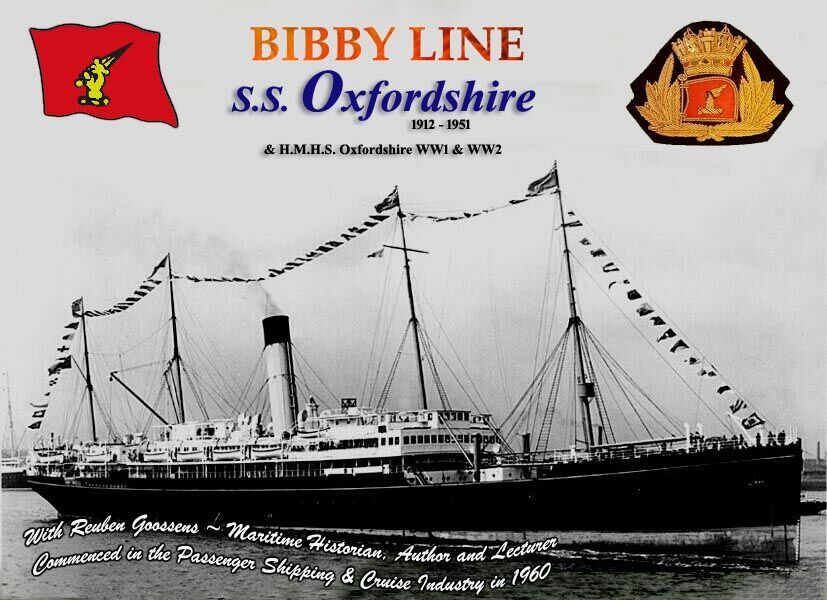
Postcards, photographs & other images are either from the author’s private collection or from my supporters.
Thus a very thank you to three very special ssmaritime supporters for sending me their wonderful
photographs & images for I could not have completed this feature to this point.
I am sorry but
some of the images shown may not be of the highest quality, but they are the
best that were available
Introduction in Brief:
The S.S.
Oxfordshire was a fine passenger liner built by “Harland & Wolff at
their

*********************
From Construction, Launching to Maiden Voyage:
She was laid
down late in 1911 in “Harland & Wolff’s” Yard No 429 and
she was launched on June 15, 1912. She was completed on September 17, 1912
undertook her Sea Trials and managed a respectable 15.5 knots maximum speed,
but would operate at around 14 knots service speed, 15.5 knots maximum. She was
delivered several days after the trials to her owners in
The Ship Externally and Internally:
Externally she was a most attractive looking ship having a black hull with a counter stern, having red boot topping and a thin red ribbon around her hull up high just under her portholes. Atop her superstructure was a gleaming white and with her four tall buff masts, a tall and slender reddish and black topped funnel she was a fine looking ship indeed.
She was designed to carry only First Class passengers, and thus offered spacious Promenade and Sports Decks, there were ample room for deck chairs for their guests, and yet space for promenading, and all the sports desired, be it deck tennis, and all the other ship board games were available.
She was specially designed in every detail for the comfort of passengers travelling to and from the East. Every cabin had direct access to fresh air and there were only single and two berth cabins. With the occasional cabin having a third berth option.
Internally the
S.S. Oxfordshire was certainly a First Class ship in every respect, as she
afforded her 247 passengers a luxurious ocean voyage in excellent Public Rooms
on Boat (A) Deck, Promenade (B) Deck, and on Poop (C) Deck. The accommodations
for the crew were located aft on B Deck as well as some forward on C Deck.
Whilst the lower decks obviously was the location for her engine room, fuel
storage, baggage room, holds, and so much more.
The Lounge:
This delightful venue was decorated in a sumptuous mahogany timber along on the walls, as well as along the four long ceiling panel’s side’s centre and those four pillars in the centre of the room, not to forget the delightful furnishings of course. The sofas and some lounge chairs were deep and soft as well as elegantly upholstered in the finest brocades. On top of the flooring, there were genuine Persian rugs on the floor. This Lounge certainly was impressive!
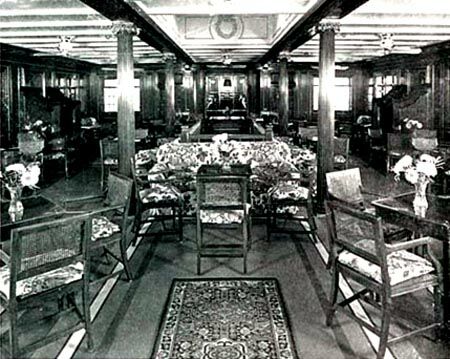
The Music Room:
The Décor in the Music Room was obviously very much in the ‘Adam’ style and it was certainly delightfully cool and most restful in every respect! The furnishings once again, like in the Main Lounge, contain deep and comfortable lounge chairs beautifully upholstered, as well as several styles of attractive timber chairs with square tables. In the corner stood a mini Grand Piano and of course there was that cosy fire place in the middle.
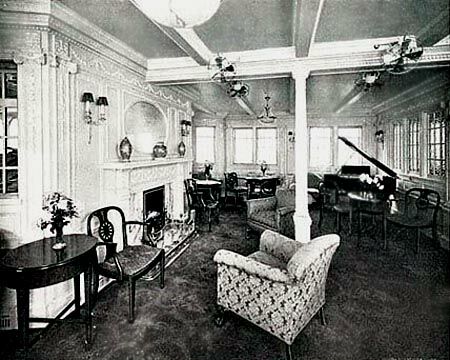
The Smoke Room:
This venue was very different to the lounge and there was no mahogany to be found anywhere, the timbers are not mentioned but as we can see they were much lighter thus could be any from a range of woods. But it certainly gave this venue a look of its own. Besides the decorative pillars and railings there is so much detail in this room that made it a beautiful venue indeed and a perfect location for a drink or two and to enjoy time with your new found friends, etc.
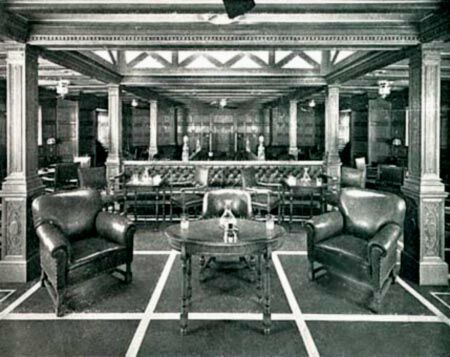
The Verandah:
The Verandah was designed to be the location where you could relax and spend time with friends and enjoy the ocean views. It was also the ideal spot regardless of the weather, for here you could enjoy yourself with a cup of tea or coffee, or a drink from the bar and read a book.
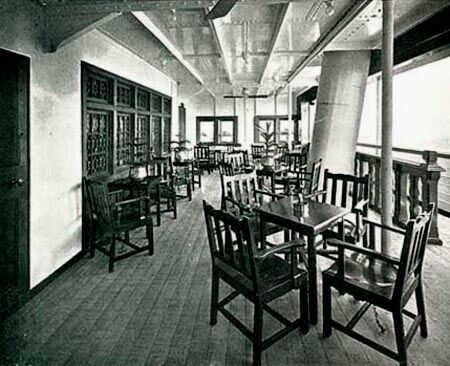
The Veranda Located aft
Dining Room:
The Dining Room was beautifully timbered and had that homely feeling with every table having a table lamp and seating varied from two, six to eight persons. The Dining Room could seat all guests at the one sitting and they were served cuisine prepared in the best of galley’s which had been fitted with the very latest facilities of the day, and the company only employed the best chefs. Service was something that the Bibby Line had long been famous for as it was simply impeccable!
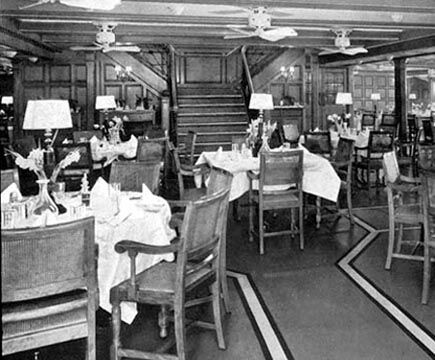
The delightful Dining Room
Accommodations:
Although the cabins compared to somewhat later times were as glamorous, but for the days she was built in 1912, it was very good indeed. The two berth cabin was a comfortable room, nicely furnished with running water and your steward would bring hot water in the morning if needed. Of course there were no private bathrooms, but the facilities outside were simply spotlessly clean and maintained throughout the day and night! The other option was a Single bed cabin, and there was also the two berth cabin with a sofa that converted into a third berth, if required.
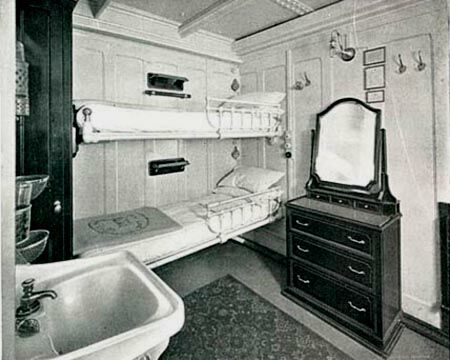
Above &
below: A two berth and a single bed Cabin, all
having a window or porthole and a genuine Persian rugs
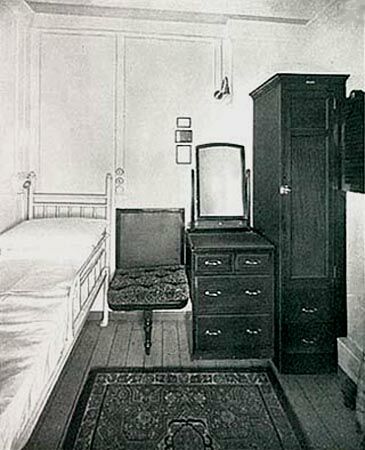
Troubled Times Ahead:
We have learned from history that tensions were really fired up in the Balkans when on June 28, 1914 following the assassination of Archduke Franz Ferdinand, the Austro-Hungarian heir by Gavrilo Princip, a Bosnian Serb. That was a month before World War One commenced, but it was the cause of it, and now commenced the complicated alliances.
Of course
World
War One:
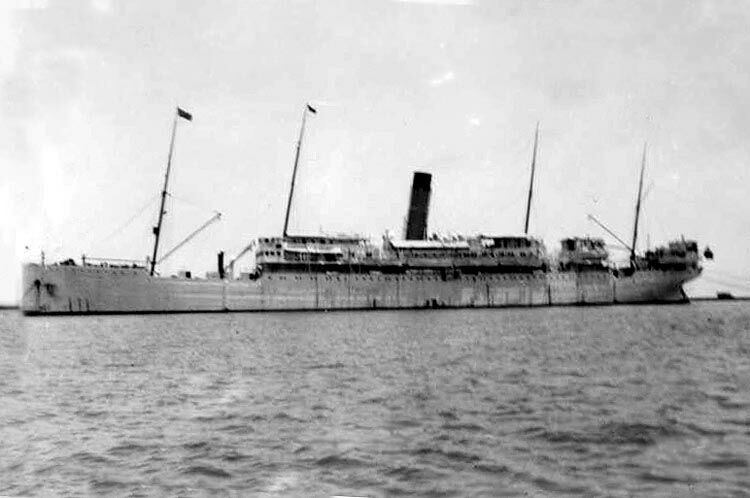
The H.M.H.S.
Oxfordshire is seen at
Thus she was
present during the ANZAC withdrawal at the
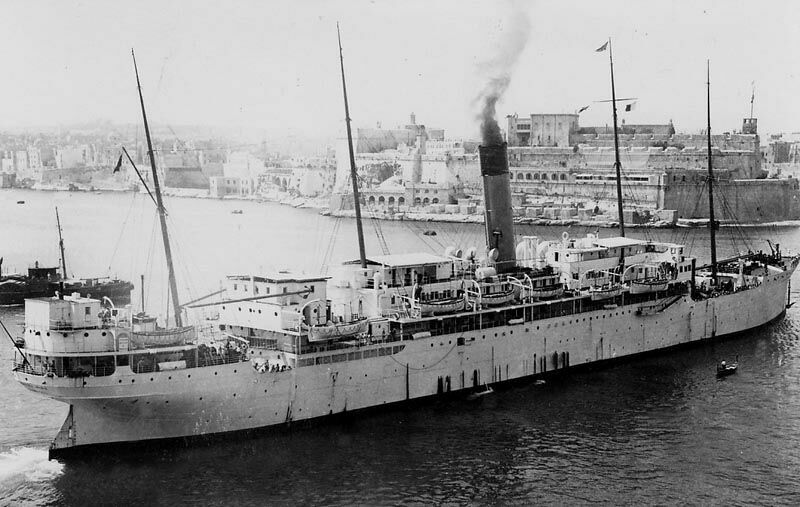
The Oxfordshire
then served in the Persian Gulf and then German East Africa during December
1916 and in 1918 she served as a shuttle hospital ship in the
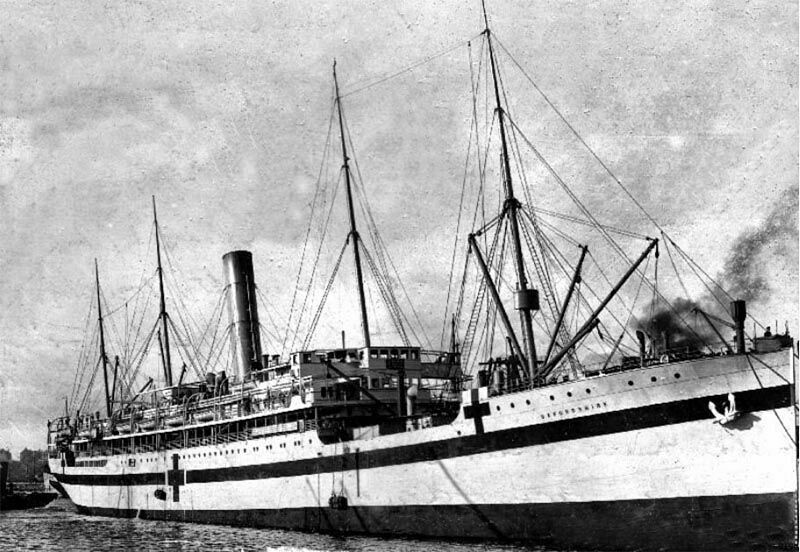
H.M.H.S. Oxfordshire No. 1 seen berthed now with a full hospital livery
She was decommissioned on March 24, 1919, having made an amazing 235 voyages, and steamed some 172,000 miles without a single mechanical problem and she carried 50,000 wounded, with is recorded as being the highest of any hospital ship during the war!
Back to Passenger Services:
She was
returned to the “Bibby Line” who sent her to “Harland &
Wolff” at
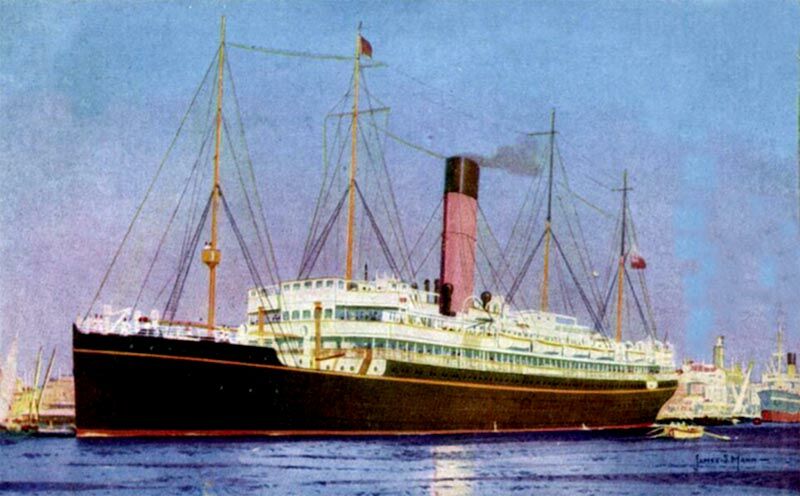
An artist
impression of the “Oxfordshire” seen departing
Soon returned
to her regular services sailing as follows; Liverpool,
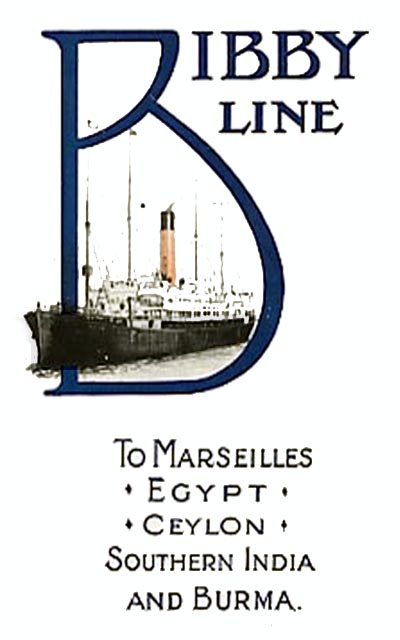
A 1920’s sailing schedule
During the 1930’s various Bibby Line ships, including the “Oxfordshire” would operate short cruises, which became very popular, and a special poster was produced as can be seen below.

She sailed on for the next twenty years without any problems as she proved herself as the ship that never seemed to fail. She just had her regular maintenance services, and back to work she would go, and it was that she was the ship that was unstoppable! Yet, her passenger services would again be stopped, not because of her, but there was another war on the way!
World War Two:
On September 3,
1939, the “Oxfordshire” was again requisitioned for war duties and
she was sent this time to the “Royal Albert Dock” in
She was
officially commissioned on September 24, 1939 and she departed
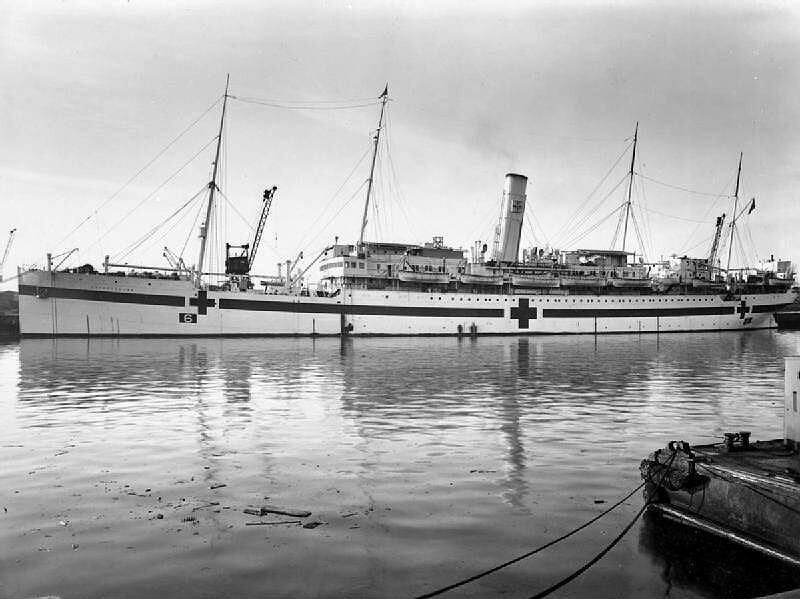
Then in September 1942 she was redeployed to the Mediterranean were she remained until 1944, when she headed back to the UK and was given a refit at the Clyde, after which she was sent to the Adriatic and on October 29, 1944, she was slightly damaged by a bomb, but survived during a voyage between Ancona and Bari.
In November
1944 she was ordered to the Far East where she would serve the Admiralty
Islands (
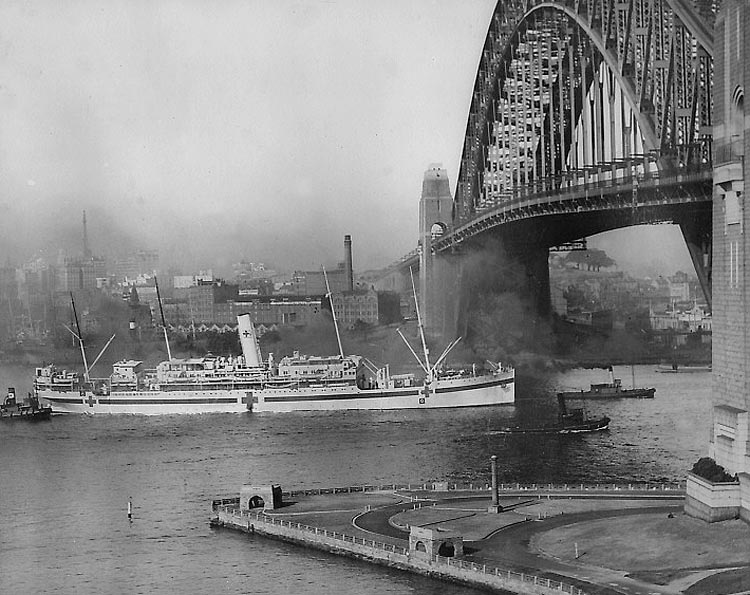
The H.M.H.
Oxfordshire is seen going under
After the defeat of Japan in 1945 the H.M.H.S. Oxfordshire was now used to repatriate wounded from Hong Kong and in May 1946 she became an Army hospital ship to return the sick home from the Near and the Far East.
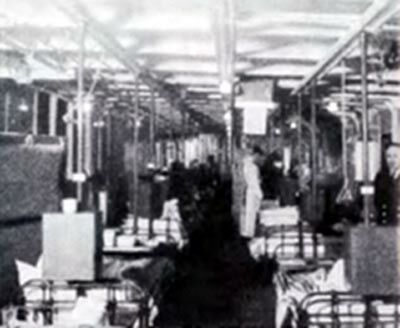
Here is a typical
ward on board and this photo was taken whilst she was at
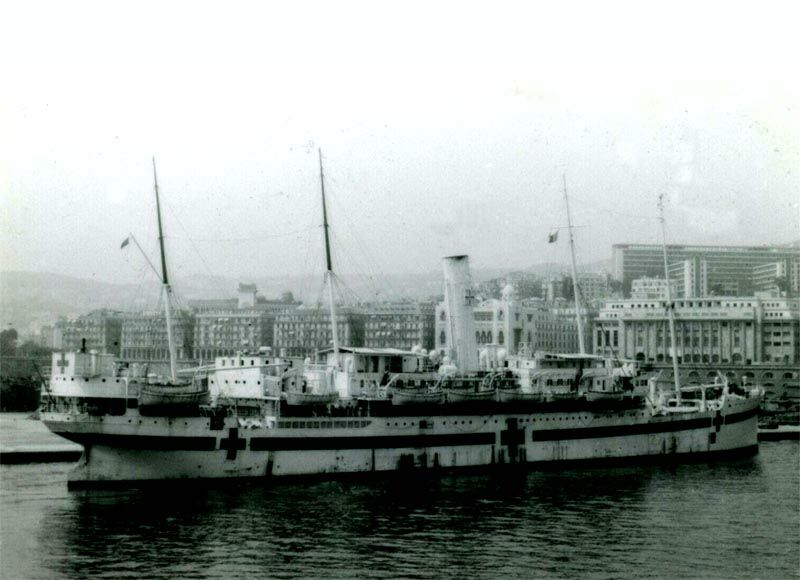
She is seen during
1946 somewhere in
She was kept
extremely busy as she was then used to repatriated Indian troops from
In 1948 she arrived home from the Holy Land, on July 19, 1948 she was finally decommissioned at Southampton having carried some 22,321 casualties during the war, and amazingly this turned out to be once more to be the very highest of any hospital ship at sea! However, on September 8, 1928 she did make one further voyage on a special charter to Jeddah filled with pilgrims, before being returned to the Bibby Line.
*********************
Several Items of interest:
Below are several items of memorabilia but there is not a great deal available for the “Oxfordshire” I am afraid, but I do have several items as well as an Officers Hat Badge.

A diner plate from
the Dining Room

An
“Oxfordshire” ashtray
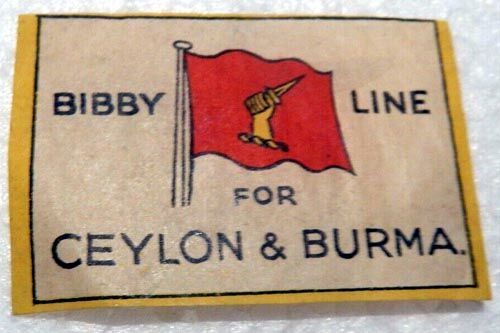
Matches were
available at the Bar, this is a cover from a box

A badge from an
Officers Hat
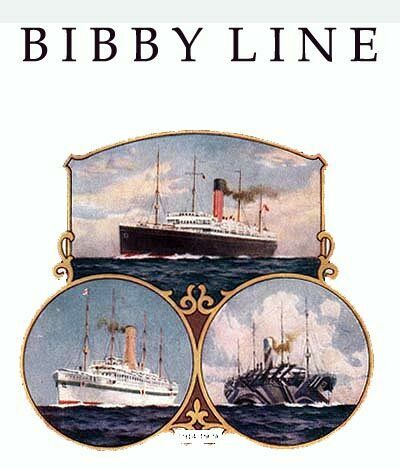
A schedule from the 1920’s
*********************
Returned to her Owners:
(But a Big Change of Direction!”)
With the “Oxfordshire” being 36 years old, it was considered that it was not worth while to bring her back to her old luxurious style, and therefore an alternative was opted for. Considering there was a demand for ultra budget travel, such as the migrant trade, as the charter operation’s, they decided to take her in that direction.
Thus she was sent “Harland & Wolff” where she was given what could be called to say the least a rather austere makeover. Upon completion she now had accommodations for 700 persons, some in cabins, but most would be accommodated in converted holds. New larger lounges and dining areas were created being very different to their original luxurious ones, but they served the purpose.
The “Oxfordshire” had already been chartered by the “International Refugee Organisation” or the “IRO”, thus her passengers would be mostly individuals and families who would be migrating to Australia after World War Two from various European Countries including Germany, Hungary, Russia, Ukraine, Latvia, Poland, Czechoslovakia and Romania, etc. The vast majority of these people were World War Two refugees or displaced persons and some were Jewish Holocaust survivors.
In April, 1949
The “Oxfordshire” would make her first voyage for the
“IRO” from

The S.S. Oxfordshire is seen here after her refit
Note the air vents far forward and the others, these are to allow
air to enter the old hold areas which are now passenger spaces
She departed
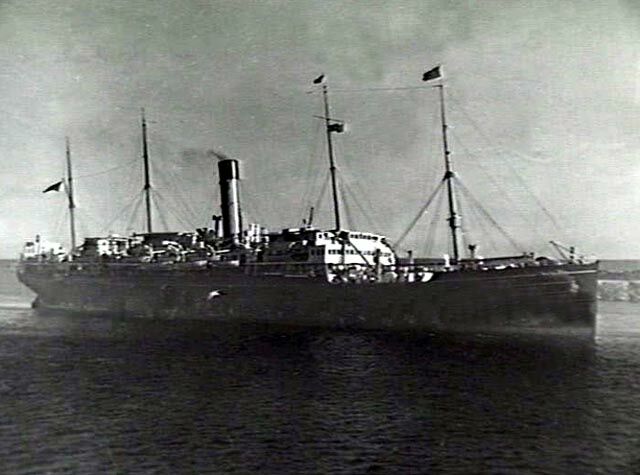
A poor image, but this is the “Oxfordshire” arriving at Fremantle for the 2nd time on June 3, 1949
I would assume that she again sailed from Naples, but have no date, but this time she headed for Western Australia and the Port of Fremantle (for the City of Perth) arriving there on August 11, 1949.
Her next
departure was from
Further Trooping Duties:
In 1950 she did
return to trooping duties between
Sold to a New Owner:
Thus she was
soon sold to “Pan-Islamic Steamship Co” of Karachi, Pakistan, and
amazingly this was their first ever passenger ship and on April 13, 1951, she
departed from Liverpool renamed “Safina-El-Arab” bound for Karachi.
They had purchased this ship mostly because of her large capacity and they
would operate her on the

S.S. Safina-El-Arab still looking very smart
After seven
years with her new owner, after the ex “Oxfordshire” having been
for 46 years in operation, in 1958 her owners decided to dispose of her and she
was sold to a local breaker in
In Conclusion:
It is worth
remembering that she is a ship that broke a number of records; for she
transported and worked on more wounded in two World Wars than any other
Name’s: S.S.
Oxfordshire 1912 - 1951.
“ S.S.
Safina-El-Arab 1951 - 1958.
Owner: Bibby Steamship Co. Ltd.
Built by: Harland
& Wolff,
Yard No: 429.
Launched: June 15,
1912.
Completed: September
17, 1912.
Official No: 131454.
Call Sign: GLZF.
Classification Society: Lloyd's Register.
Registered at:
Tonnage: 8,623, 5,439 NET
Later: 8,646 GRT.
Length: 474.6 ft – 144.63m.
Width: 55 ft - 16.76m.
Draught: 32.1 - 9.78 m.
Type: Passenger-Cargo Liner.
Engines: Quadruple-expansion Steam
Engine.
Details: 2 Quadruple expansion
steam engines with cylinders of bore 22”, 31˝”, 46" and
66” with stroke 51”.
Built by: Harland
& Wolff,
1919: Converted from coal to
Oil burning.
Boiler Details: 2 double-ended
and 2 single-ended boilers operating at 215 psi.
Propellers: Twin Screw.
Power: 906 MN.
Speed: 14 knots service speed,
15.5 maximum speed.
Accommodations: 276 First Class Only.
1914 WW1: Hospital
Ship No.1 with 562 Patient beds.
1939 WW2: Hospital
Ship No.6 with 500 Patient beds.
Decks: Three Passengers Decks.
“ Two
Decks for crew and other needs.
Additional Info: Fitted with radio direction finding and submarine signalling equipment.
Sold: In
1951 to ‘Pan-Islamic SS Co’,
Fate: Sold in 1958 to ship
breakers in
Remembering the Delightful
S.S. Oxfordshire

An excellent
artist impression of the 1912 constructed “Bibby Liner” the S.S.
Oxfordshire
“Blue
Water Liners sailing to the distant shores.
I watched them come, I watched
them go and I watched them die.”
Featuring over 1,435 Classic Passenger Liners, Passenger-Cargo Liners & Classic Cruise Ships!
Or ENTER HERE
For interest: Sadly an email service to ssMaritime is no longer available, due to the author’s old age and chronic illness as well as being disabled, etc. In the past ssMaritime received well over 120 emails per day, but Mr. Goossens can no longer handle same. He sincerely regrets this!
*********************
ssMaritime.com & ssMaritime.net
Where the ships of the past make history & the 1914 built M.S. Doulos Story.
The Author has been in Passenger Shipping & the Cruise Industry for well over 60 years
In addition he was the founder of “Save the Classic Liners Campaign” in 1990.
Please Note: ssmaritime and associated sites are 100% non-commercial and the author seeks no funding or favours of any shape or form, never have and never will!
Photographs on ssmaritime and associate pages are by; the author or from the author’s private collection. In addition there are some images that have been provided by Shipping Companies and private photographers or collectors. Credit is given to all contributors. However, there are some photographs provided to me without details regarding the photographer/owner concerned.
This notice covers all pages; although, and I have done my best to ensure that all photographs are duly credited and that this notice is displaced on each page, that is, when a page is updated!
ssMaritime is owned & © Copyright by Reuben Goossens - All Rights Reserved

